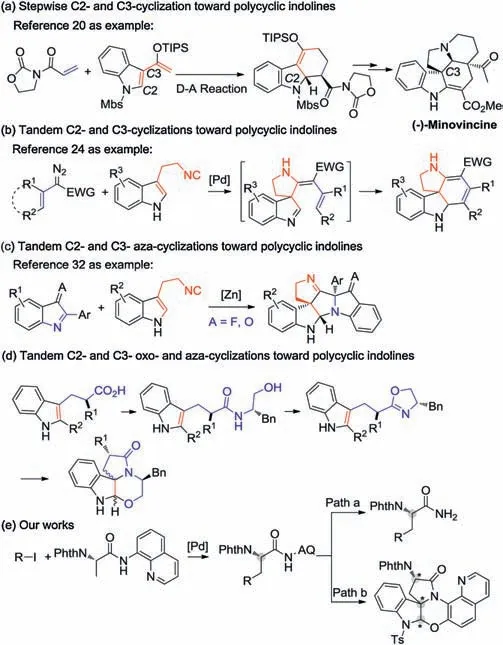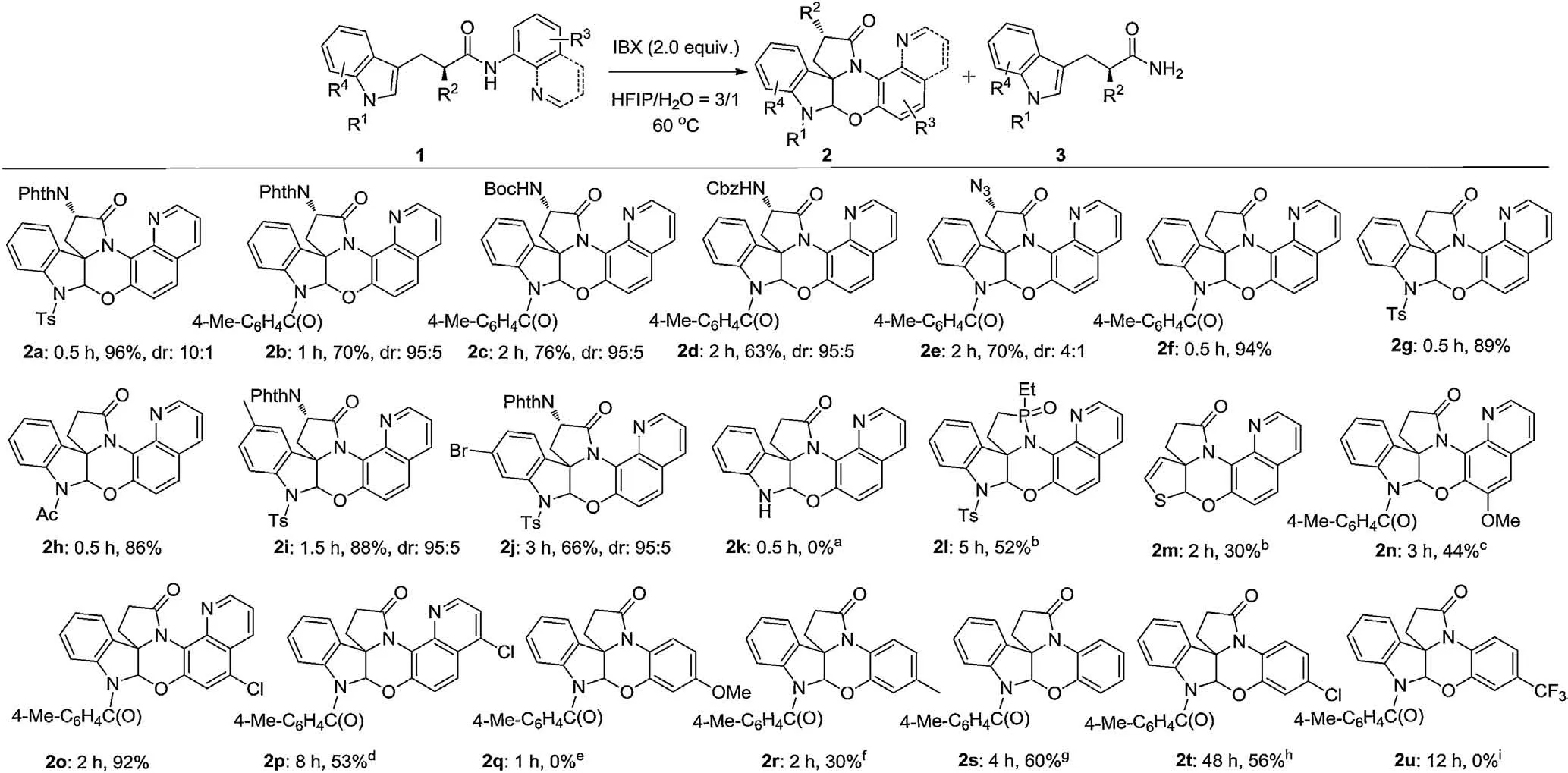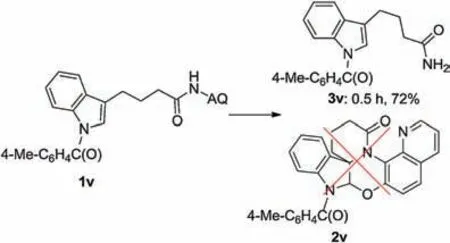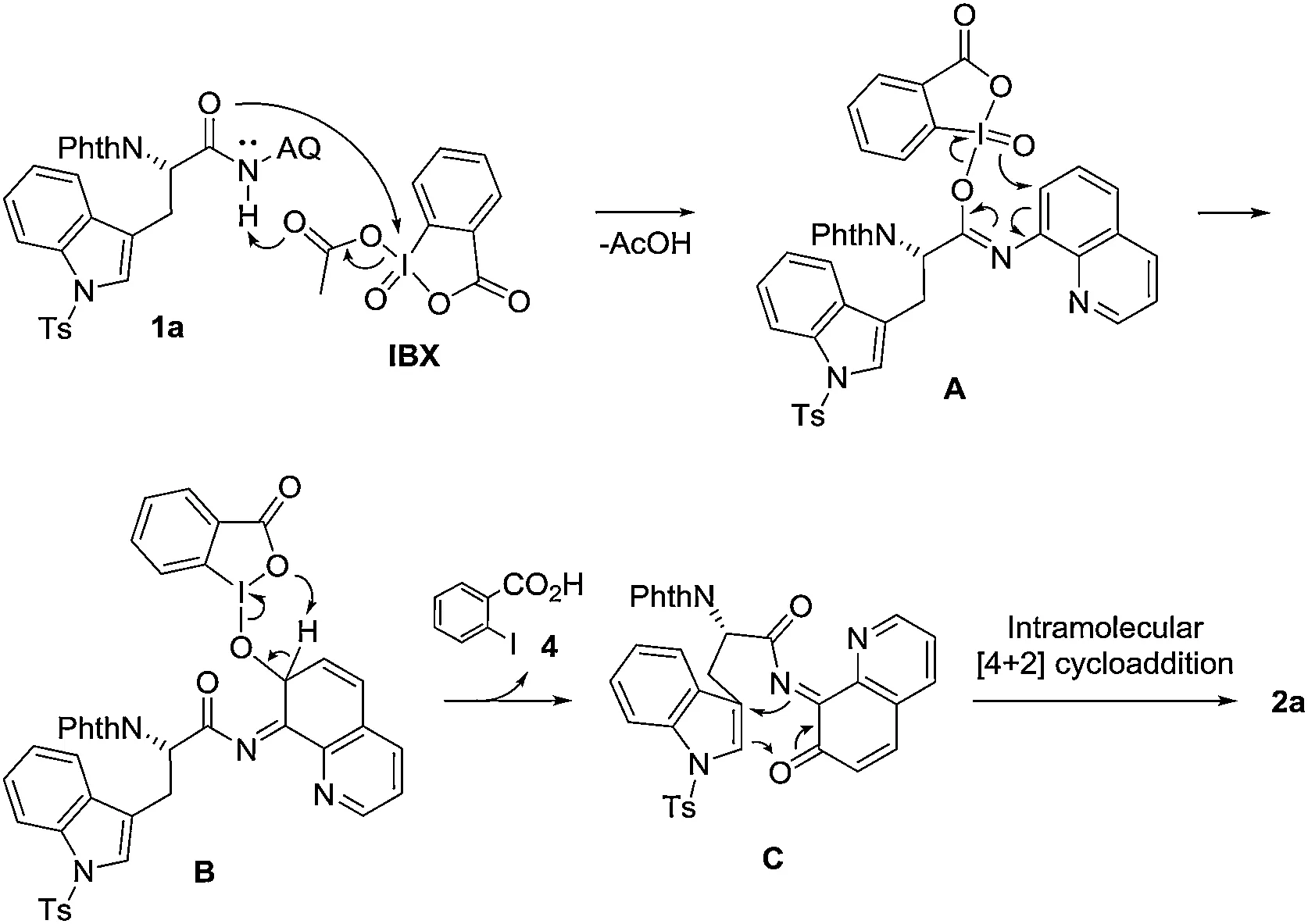Synthesis of polycyclic spiro-fused indolines via IBX-mediated cascade cyclization
2021-10-14ZhiguoZhngXioqingSongGuofengLiXingLiDnZhengXunZhoHunrnMioGuishengZhngLntoLiu
Zhiguo Zhng*,Xioqing SongGuofeng LiXing LiDn Zheng,Xun ZhoHunrn MioGuisheng Zhng*,Lnto Liu
a Henan Key Laboratory of Organic Functional Molecule and Drug Innovation, Collaborative Innovation Center of Henan Province for Green Manufacturing of Fine Chemicals, Key Laboratory of Green Chemical Media and Reactions, Ministry of Education, School of Chemistry and Chemical Engineering, Henan Normal University, Xinxiang 453007, China
b Quality and Technique Supervision, Inspection and Testing Center of Xuchang City, Xuchang 461000, China
c The College of Chemistry and Chemical Engineering, Shangqiu Normal University, Shangqiu 476000, China
ABSTRACT We report a 2-iodoxybenzoic acid (IBX)-mediated intarmolecular oxidative spiro-fused tandem cyclization reaction of tryptophan analogs bearing an N-arylamides side-chain to rapidly afford polycyclic spiroindolines featuring multiple stereocenters including a quaternary stereocenters under mild reaction conditions.Among them,a novelty azaphosphol idine-containing spiroindoline compound is synthesized for the first time.It may open the door to azaphos pholidine-containing spiroindoline compound of potential interest in synthetic and medicinal chemistry.A plausible mechanism is proposed.
Keywords:Spiro-indolines Fused indolines 2-Iodoxybenzoic acid Hypervalent iodine reagents
A large number of complex indole- and indoline-containing alkaloids have been isolated from the natural products [1-4] and have become an area of intensive interest in synthetic organic chemistry [5-9].Currently, C3-spirocyclization toward polycyclic indoles and indolines has been well studied [10,11].And C2-spirocyclization of indolines is also occasionally reported although low reactivity at this position[12-15].In addition,the construction of complex polycyclicindolines involving the C2-and C3-positions completed by a multistep reaction have also been well investigated(Scheme 1a)[16-23].Cycloaddition reaction is the most commonly used domino process to synthesize complex polycyclic indolines with the C2-and C3-positions participating in the transformation simultaneously (Scheme 1b) [24-31].Synthesis of polycyclic spiroindolines with oxa- and/or aza-tandem C2- and C3-cyclizations is relatively rare(Scheme 1c)[32-34].In 1999,Ciufolini et al.[34] reported a total synthesis that produced oxa- and azapolycyclic spiro-fused indolines in the presence of BOP-Cl,Burgess reagent, and PhI(OAc)2starting from tryptophan analogs and (S)-phenylalaninol (Scheme 1d).They achieved five kinds of desired oxazine-containing spiro-fused cyclic structures via four steps reactions, but no more than 50% yields were obtained in the final transformation even for adjust the substituents of the tryptophan analogs,lowering the overall yields.However,the highlight of the reaction is the nucleophilic N and O atom on the side chain expressing electrophilicity, and reacted simultaneously with both C2- and C3-position of indoles core in the final oxidative cyclization step.Another worthy-of-noting similar case is Dess-Martin periodinane-mediated cyclization reaction of unsaturated anilides by Nicolaou in 2002 [35].A plethora of phenoxazinecontaining heterocycles are accessible in 0-57%yields by employing γ,δ-unsaturated amides, urethanes, or ureas as substrates via an o-imidoquinones species oxidized in site from the arylamide moiety.Despite these significant advances, important issues such as high yield, broad applicability, functional group tolerance, and process economy remain to be improved for the existing protocols[24,36,37].Thus, it remains challenging to efficiently synthesize oxazine-containing polycyclicindolines relevant to biological systems through cascade sequence with the C2-and C3-positions of the indole analogues participate in the transformation simultaneously.

Scheme 1.C2- and C3-cyclization toward polycyclic indolines.
The importance of hypervalent iodine reagents in organic synthesis has been amply demonstrated in recent years [38-44].Recently, we reported a series of efficient and chemoselective methods to convert various secondary N-arylamides to primary amides in high yields with the treatment of organoiodines in mixed solvents of H2O and HFIP (Scheme 1e, path a) [45,46].These regiospecific C(aryl)-N bond cleavage reaction without touching the C(carbonyl)-N bond in the amides,not only further enriches the amino group protecting chemistry,but also provides a way for the facile removal of the aminoquinolines(AQ)directing group under mild conditions.During these research, we found a tryptophan analogs, which was derived from Pd-catalyzed AQ-directed β-C(sp3)-H indolization of aminoacid derivatives, produced the oxazine-containing polycyclic spiro-fused indolines via domino C2- and C3-oxidative cross-coupling reaction, rather than the primary amide via C(aryl)-N bond cleavage reaction (Scheme 1e,path b).This competitive observation motivated us to optimize the efficient tandem strategies for construction of structure diverse oxazine-containing complex polycyclicindolines due to their importance for biomolecular and application for pharmaceutical lead discovery [47-49].
As shown in Table 1, tryptophan derivative 1a was selected as the model substrate[50].We were pleased to see that the tandem cyclization took place to afford the polycyclic indoline 2a in 96%yield with good diastereoisomer(dr:ca.10:1)in the presence of 2 equiv.of IBX in mixed solvents of HFIP and H2O (3:1) at 60。C for 0.5 h (entry 1).The structure of 2a was confirmed by X-ray crystallography studies (CCDC: 1890504).Compared with the results performed in the mixed solvents of HFIP and H2O in the ratio of 1:1,obviously,increasing solubility is helpful in improving the yield of target molecule(entry 2).As expected,the reaction did not occur in H2O due to the poor solubility of IBX (entry 3).No product was obtained in HFIP either, and a large amount of substrate was recovered(83%)(entry 4).This observation indicated that H2O is involved in the transformation [35].Moreover,increasing the ratio of HFIP and H2O to 5:1 gave a slightly lower yield than that of 3:1 (entry 5).Other organic solvents including 2,2,2-trifluoroethanol (TFE), 2,2,3,3-tetrafluoro-1-propanol (TFP),2,2,3,3,4,4,5,5-octafluoro-1-pentanol(OFP)mixed with H2O in the ratio of 3:1 not gave a higher yield (entries 6-8).Reactionsconducted at 25。C and 45。C gave slightly lower yields of 2a,besides requiring dramatically more reaction time (entries 9 and 10).

Table 1 Reaction optimization.
With the optimal reaction conditions in hand(Table 1,entry 1),we then evaluated the scope of tryptophan analogs [51-53].As shown in Scheme 2, Ts-group protected tryptophan derivative 1a gave 2a in 96%yield with ca.10:1 dr value.Preliminary exploration on the protecting group on the N atom of indole moiety suggested that the 4-methylbenzoyl protect group also fit for the aminoacid substrates.Compound 2b worked well to give the primary amide products in good yield.Variants of various amino groups such as BocNH-(1c),CbzNH-(1d),and N3-(1e)on the side chain were well tolerated and generated corresponding products 2c, 2d and 2e in 76%, 63% and 70% yields, respectively.The experiments of nontryptophan analogs with a 4-methylbenzoyl protect group for the cyclization were also performed.Compound 1f gave a slightly higher yield(2f:94%)than that of Ts-and Ac-protected substrates 1g(2g:89%)and 1h(2h:86%).To our delight,starting materials 1i and 1j with Me- and Br-substitution on the indole moiety also worked well, and gave products 2i and 2j in 88% and 66% yields,respectively.However,N-unprotected starting material 1k failed to give desired compound 2k.

Scheme 2.Extended scope of tryptophan analogs.Isolated yield on 0.2 mmol scale under the standard conditions and the dr value was determined by 1H NMR.a Complex mixture.b Alone with some unidentified byproduct.c 25%of 3n was obtained.d 8%of 3n was obtained.e43%of 3n was obtained.f 36%of 3n was obtained.g 27%of 3n was obtained.h 34% of 1t was recovered.i 93% of 1u was recovered.
Pleasingly, phosphinamide derivative possessing an aminoquinoline unit(1l)[54]also worked,and polycyclicindolines 2l was synthesized in 52%yield,along with small amounts of unidentified byproducts.To the best of our knowledge, this novelty azaphospholidine-contaning spiroindoline compound is synthesized for the first time.This unusual spiroheterocycles open the door to a series of new azaphospholidine-containing spiroindoline compound of potential application in synthetic and medicinal chemistry.In addition, this strategy was also amenable to the building of thieno[1,4]oxazino[2,3-h]quinolinone structure (2m)although a slightly lower yield was obtained.
In addition, we found that the substitution on the quinoline significantly affects the reaction.The reactant(1n)with an alkoxyl(MeO-)at the 6-position afforded the desired fused cyclic product 2n in 44%yield,along with 25%primary amide byproduct 3n.The reactant bearing a Cl- group located at the 5-position gave the target product 2o in a yield of 92%.Even the materials with the Clgroup at the 4-position of the AQ moiety can also deliver the product 2p in moderate yield, along with a small number of primary amides byproducts 3p, which was generated by cleavage of the amide.
The scope of other substrates was also evaluated.Reaction of 1q gave the primary amide 3q in 43% yield, rather than desired polycyclic product 2q.Interestingly, compounds 1r-1t afforded oxazine-containing polycyclicindolines 2r-2t in 30%,60%and 56%yields, along with 36%, 27% and 34% primary amide 3r-3t,respectively.In contrast, functional groups such as CF3- (1u)interfered with the IBX-mediated oxidation-cyclization tandem reaction with starting material largely recovered.
As a further test of the power of this strategy in building of complex molecular diversity,we enlisted the indole analogs with a longer side chain (1v) as a substrate [55,56] and tested the formation of the complex polycyclic 2v(Scheme 3).As a result,no target molecule formed,and only primary amide 3v was observed(72%) [45].
As outlined in Scheme 4, the IBX-mediated spiro-fused cyclization likely starts with the reaction of amide O atom of 1a with iodo center of IBX to form iodoimidate A by releasing one molecular of AcOH [45,57].Intramolecular nucleophilic attack of the oxo group on the iodine center of A onto the ortho-position of AQ group triggers dearomatization of the aniline moiety and the cleavage of the O--I bond to form B [35,57].Deprotonation and cleavage of O--I bond of B gives o-iminoquinone species C and 2-iodobenzoic acid(4)[58].The o-imidoquinone C then engages the proximate olefin in an inverse electron demand hetero Diels-Alder reaction to furnish the observed polycyclic 2a [35].It should be noted that 4 was observed in the transformation as a byproduct.

Scheme 3.Attempt for complex molecular.

Scheme 4.Proposed mechanism.
In summary, an IBX-mediated intarmolecular oxidation spirofused cyclization of tryptophan analogs bearing an N-arylamides side-chain was developed for rapidly access to polycyclic spiroindolines in moderate to excellent yields under mild conditions.This tandem reaction features high efficiency in the construction of two stereocenters in one step including one quaternary carbon stereocenter harboring 5-8 rings.Among them,a novel azaphosphol-idine-contaning spiroindoline compound is synthesized for the first time.It may open the door to a series of azaphos-pholidine-containing spiroindoline compound of potential interest in synthetic and medicinal chemistry.Mechanistic studies showed oxidation of the aryl group produced an oiminoquinone intermediate which afforded terminal products via intramolecular hetero Diels-Alder reaction.Overall, this strategy nicely complements the construction of structure diverse oxazinecontaining complex polycyclicindolines for biomolecular purpose in future.
Declaration of competing interest
We declare that we have no known competing financial interests or personal relationships that could have appeared to influence the work reported in this paper.
Acknowledgments
We thank the National Natural Science Foundation of China(Nos.U1604285,21772032 and 21702051),Program for Changjiang Scholars and Innovative Research Team in University (PCSIRT) of Ministry of Education of China (No.IRT1061), the 111 Project (No.D17007), Henan Provincial Natural Science Foundation (No.162300410180), Key Project of Henan Educational Committee(No.18A150009) and Program for Innovative Research Team of Science and Technology in the University of Henan Province (No.18IRTSTHN004).
Appendix A.Supplementary data
Supplementary material related to this article can be found,in the online version, at doi:https://doi.org/10.1016/j.cclet.2020.11.001.
杂志排行
Chinese Chemical Letters的其它文章
- D-A-D structured selenadiazolesbenzothiadiazole-based near-infrared dye for enhanced photoacoustic imaging and photothermal cancer therapy
- Synthesis and biological evaluation of a lipopeptide-based methamphetamine vaccine
- Nucleic acids induced peptide-based AIE nanoparticles for fast cell imaging
- Titanate nanofibers reduce Kruppel-like factor 2(KLF2)-eNOS pathway in endothelial monolayer: A transcriptomic study
- Drug-induced hierarchical self-assembly of poly(amino acid) for efficient intracellular drug delivery
- Co-delivery of anticancer drugs and cell penetrating peptides for improved cancer therapy
